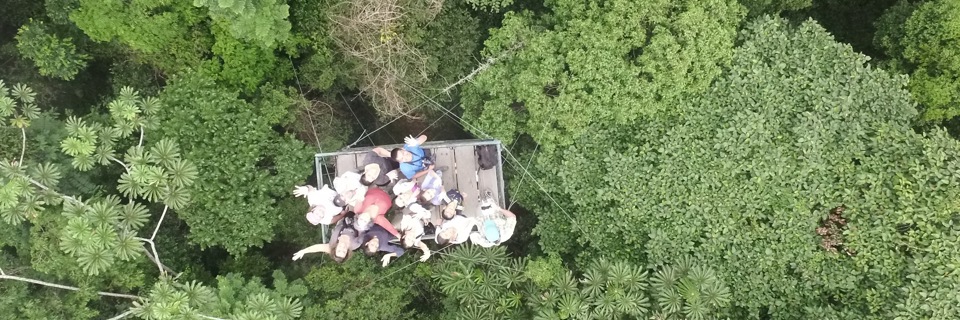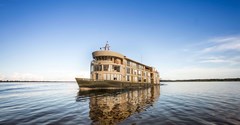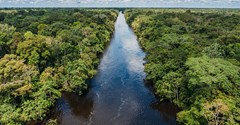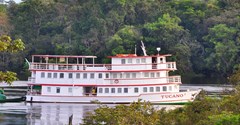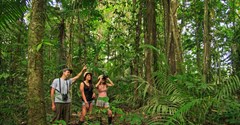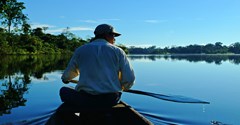Discover what to do in the Amazon Rainforest. Experience life in the jungle, spot exotic wildlife, meet local communities and much more.
Stretching into nine South American countries, the region of Amazonia comprises the lowland basin surrounding the Amazon River and its tributaries. Most common estimates put the Amazon Basin at around 2.7 million square miles, an area of land roughly twice the size of India and four times that of Mexico. It is home to many thousands of different plant, bird and fish species and hundreds of Amazonian tribes, some of which have never had contact with the outside world. Many trees grow to 100 feet tall and have lived for over 500 years, some over 1,000. 20% of all the world's oxygen is said to be created by the Amazon, which itself accounts for around half the rainforest left in the world today.
All of these startling facts and figures vividly demonstrate the extraordinary size, biodiversity and importance of the Amazon Rainforest, but let's try and get a broader picture of the part that you as a visitor would most likely experience. We present six different ways to experience the Amazon, to give you a complete in-depth perspective on the world's biggest rainforest.
1. Traverse the waterways for magnificent views
The Amazon River itself deposits as much water into the ocean in one day as which passes through London in the Thames in one whole year and - at over 4,000 miles - totals the equivalent in length as four and a half journeys between John O'Groats to Land's End. The source of the river is actually high up in the Andes Mountains in Peru, from where it drops fairly sharply, before flattening out and is eventually discharged in the Atlantic Ocean via six different rivers and having crossed Brazil from west to east.
The most famous part of the river is a four mile stretch, near the Brazilian port city of Manaus, where the light silty waters of the Rio Solimões run side-by-side with the dark waters of the Rio Negro. This is called the 'Meeting of the Waters' and is considered one of the great natural phenomenons of the continent. It is only from this point that Brazilians actually call it the Rio Amazonas. As well as creating an unusual and striking landscape, it is also a favourite spot of the pink river dolphin, which can be frequently seen from your boat.
In the southern part of Peru, most of the best lodges are clustered around the Tambopata River and in Ecuador the lodges and cruises are based around the Napo River. Whilst both of these waterways are many hundreds of miles away from the famous Amazon River, they both provide an equally enriching and authentic Amazon experience. What's more, the sunsets here are equally stunning!
 Meeting of the Waters near Manaus (by Juma Lodge), Amazon sunset (by Visit Brasil)
Meeting of the Waters near Manaus (by Juma Lodge), Amazon sunset (by Visit Brasil)
2. Explore diverse rainforest habitats
It would be easy to think that the Amazon is comprised of little more than endless rainforest, intersected by myriad mighty rivers. When delving into the jungle we actually encounter a range of very different habitats, from swamps, to floodplains and even savanna. Let's take a look at those which you might actually encounter on your visit to the Amazon.
The majority of the rainforest, around 90%, is made up of terra firme - land which is on higher ground and so does not flood in the rainy season. This is where we often find towering evergreen trees with dense closed canopies and, at ground level, an abundance of flowers, insects and plant life. The disadvantage of terra firme tends to be that, given the height of the trees and the density of the canopy, it can be quite tricky to spot the wildlife here (hence the observation towers which we will soon discuss).
Around 2% of the Amazon basin is comprised of flooded forests. When the rainy season begins in the Andes and the snowfall starts to melt, some of the resultant mass of water reaches these forests, which are flooded for around 8 months of the year. The major benefit of this for a visitor is that boat trips can take you through these bizarre landscapes and actually bring you much closer to the tree canopies, where we find much of the wildlife. Flooded forests are typically separated into two groups; várzea forests are generally 'milky coffee' in appearance and their nutrient-rich water is conducive to growth, whilst igapó forests are 'black tea' in colour and more acidic in nature, therefore they are less likely to produce flora and sustain wildlife.
Other smaller habitats include palm swamps and oxbow lakes, the latter of which are formed when wide river bends become cut adrift from the main body of water, forming separate lakes. By nature the wildlife here, including caiman and monkeys, is more contained and so easier to observe.
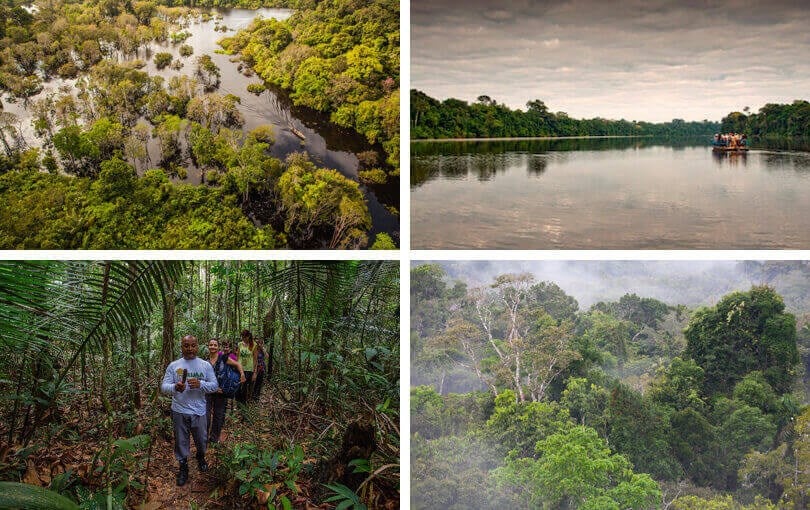 Clockwise from top: Flooded forest (by Visit Brasil), Oxbow Lake (by Perunature), Amazon canopy, Nature walk (by Juma Lodge)
Clockwise from top: Flooded forest (by Visit Brasil), Oxbow Lake (by Perunature), Amazon canopy, Nature walk (by Juma Lodge)
3. Marvel at the exotic wildlife of the jungle
Unsurprisingly, the world's biggest rainforest is home to a mind-boggling number of birds, mammals, reptiles, amphibians and insects. Whilst specialist guides are trained to sense the presence of the wildlife and help you spot them, this is often a difficult undertaking as you follow trails and enjoy rides in motorized canoes or traditional riverboats. This is due in large part to the overwhelming scale and size of the Amazon, as well as the towering height of the trees and the density of the canopy.
As you will see below, there are a number of special activities that are designed to help you see a cross-section of the animal life of the Amazon, but wildlife enthusiasts may consider combining the Amazon with the Pantanal in Brazil or the Galapagos Islands off the coast of Ecuador. See below for some itinerary ideas.
As mentioned, there are a number of ways that you can get closer to the huge array of wildlife here, without disturbing it. In Peru and Ecuador in particular are the clay licks which are frequented by innumerable flocks of colourful macaws, parrots and parakeets, as well as some small mammals in some cases. Canopy observation towers give you access to both the canopy and the understory, where you will stand a greater chance of spotting exotic birds and monkeys and perhaps sloths and (if you are very lucky) even the elusive jaguar, which are known to occasionally rest on branches a little way off the ground.
Traversing the waterways in canoes and kayaks could help get you closer to some of the more wary wildlife of the rivers and naturally occurring oxbow lakes are also excellent places to see animals in a more confined space. One other popular activity is to venture out into the rainforest under the cover of darkness to spot nocturnal creatures, including caiman, frogs, insects and night monkeys. As previously mentioned, the Sacha Lodge in Ecuador also has its own butterfly house.
Learn how visiting the Amazon at different times of the year can determine your chances of seeing different types of wildlife.
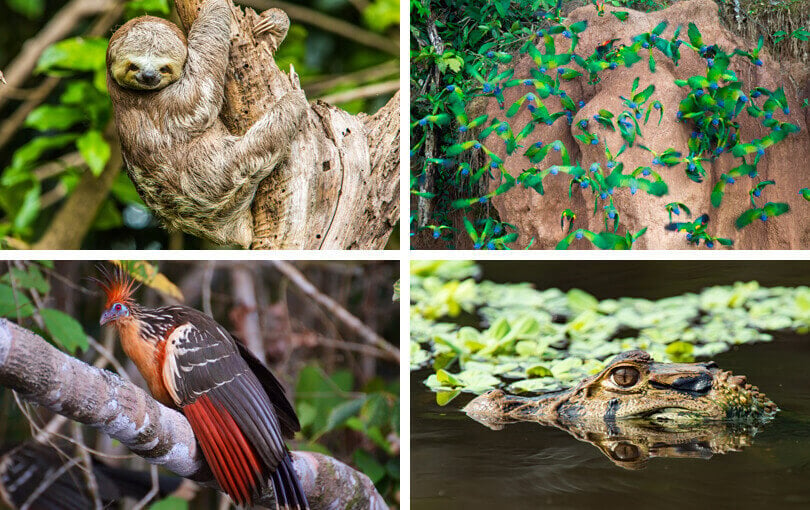 Clockwise from top: Sloth (by visit Brasil), Macaw & parrot clay lick, Caiman, Hoatzin (by La Selva Lodge)
Clockwise from top: Sloth (by visit Brasil), Macaw & parrot clay lick, Caiman, Hoatzin (by La Selva Lodge)
4. Admire giant trees and extraordinary plant life
When we speak about the incredible biodiversity of the Amazon, we are not only referring to the abundance of wildlife found here, but equally the plant life and flowers found in the jungle and the immense size of the trees that grow here. Some of the most notable trees found in the Tambopata Reserve in the Peruvian Amazon for example include the 40 metre high Brazil Nut tree, the 50 metre high Ceiba tree and the 500 year old ironwood trees.
Specialist guides lead you along established trails which showcase the plant life that exists way below the canopy at ground level. Here you will encounter verdant ferns, tropical twisted vines and tangled lianas, as well as delicate orchids and lush bromelaids. Many other epiphytes are sustained by host plants and trees, creating miniature forests within forests, into which you can peer.
The annual rising water levels create floating meadows, which along with oxbow lakes, create natural habitats for a number of water plants. Perhaps the most famous example of these are the giant Amazon water lilies, which exist in the nutrient-rich waters of várzea swamps and flooded forests. These photogenic pads can sometimes grow up to 6 feet wide.
Whatever the shape, size or family of the plant, you can bet that there's an interesting story behind it, perhaps the remarkable way it has adapted to thrive in the jungle, the unique conditions which have coincided for this to be possible or maybe the way the plant is used by locals for essential medicine, food and clothing.

5. Meet local communities to witness life in the jungle
Meeting the local communities of the Amazon to learn about life in the jungle is an important part of your comprehensive experience. These visits tend to be based around various cultural activities, including tours of their villages and homes, the sharing of stories, greetings and local legends and perhaps some fishing. At some you can also take part in a tea ceremony or learn the art of face painting. There will also typically be the chance to sample some local cuisine, purchase some handicrafts and learn about how the communities survive in the immensity and isolation of the rainforest, passing their knowledge down through the generations.
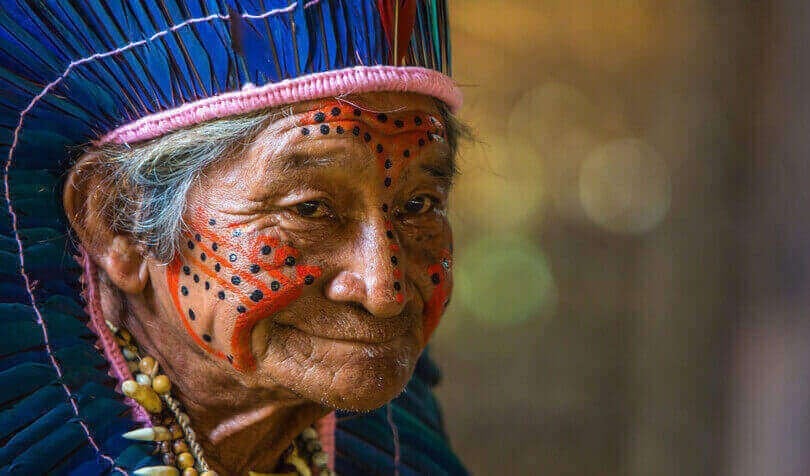 Amazon community member (by Visit Brasil)
Amazon community member (by Visit Brasil)
6. Connect with the rainforest on a range of activities
You might not immediately consider the Amazon as an 'adventure playground', but there are a number of activities available to help you interact with the jungle and get an essence of life here. Some of these are designed to give you a birds-eye view of the rainforest and help get you closer to the canopies. Those staying at the Posada Amazonas or Refugio Amazonas in Peru or the Juma Lodge in Brazil could take the opportunity to scale one of the towering trees of the jungle, using a system developed by scientists to be able to better study what happens high up above the ground. In Ecuador, the Sacha Lodge offers its guests the chance to cross its vast treetop walkway.
Following established nature trails on foot is a staple activity of any visit to the Amazon Rainforest, but you could also choose to follow one of these on mountain bikes if staying at certain lodges in the Tambopata region in Peru. Other activities help you better connect with the waterways of the region, with kayaking and stand-up paddle boarding on offer and a range of fishing activities, including piranha and pirarucu fishing.
 Kayaking & tree climbing
Kayaking & tree climbing
If you have been inspired to visit the Amazon then we invite you to browse our selection of Amazon holidays below, typically combined with the likes of the Galapagos Island, Machu Picchu and the Sacred Valley or Rio de Janeiro and Salvador da Bahia, depending on the country. If you have further questions or would like to discuss your own tailor-made Amazon tour, please do get in touch!
Choose your perfect holiday
Find inspiration from our selection of itinerary suggestions, a great starting point for your next trip
View More Tours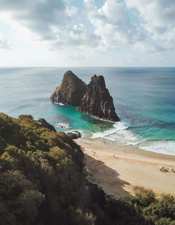
Stay in touch
Infuse your travels, with inspiration from our monthly newsletter.
READY - 20 April 2024
LANDMARK TOURS: Multi-Country & Cross Continent. New Cosmopolitan Tour: Buenos Aires, Iguazu, Rio
CHINA & INDIA: Local Life, People & Unique Cultures
GUIDES by Veloso Tours, are the best Local Hosts
PRIVATE VILLAS: Quality Time in exclusive settings
TRAVEL INSURANCE with extensive COVID-19 cover
